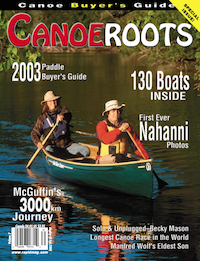Most of what I know about canoeing, I learned from my dad. He is the inspiration behind my passion for solo paddling. As a filmmaker, Dad was always looking for an excuse to make another film involving canoes. In the late ‘70s, he explored the possibility of making a short film on what he called “canoe ballet.” Canoe ballet is a flashy style of solo paddling popularized in the ‘50s by camp instructors like Omer Stringer. In canoe ballet, the canoe is heeled over so the gunwale almost touches the water and the paddler fluidly connects various manoeuvres together with as little splashing as possible.
I was to be the principal paddler in his new film. To prepare for the shoot I had to learn, practice and perfect many different strokes. Perhaps the hardest of these was the dreaded one-hand pry—a showy way to turn 360 degrees on a dime by inserting, with one hand, a pry stroke at the bow. To practice, I would pick up steam, skim the paddle blade along the surface of the water toward the bow and wedge it into place alongside the hull. If I cut the blade in too late I would miss the turn and ram the dock, rattling my teeth in the process. Too early and I’d catapult myself right out of the boat!
After about a year of training, I was ready. Dad shot the pilot with the working title The Magic Paddle, but before the film was brought to final production Dad retired from filmmaking. It seemed a shame after all my training that nobody would see the film. Dad encouraged me to teach a course so I might pass on the skills I’d perfected. Over tea one day in 1987, we came up with the term “classic solo” to describe the style of canoeing that became the basis for my courses.
Classic solo canoeing is a great way to develop basic canoeing skills because it allows you to see an immediate cause and effect of your actions more clearly than in tandem paddling.You end up with a versatile package of flatwater solo skills that allows you to paddle a canoe comfortably, efficiently, with grace and confidence in all conditions. Whether I go for a week-long wilderness adventure, a canoe ballet spin at sunset, or an afternoon exploring a breezy lake, I utilize much of the classic solo stroke repertoire.This versatility is a rare thing for our times when most sporting activity is compartmental- ized and specialized to the extreme.The real plus of going solo, however, is that it allows you to journey at your own pace and it gives you the freedom to follow your whims and your dreams.
When I was 10, my very first solo adventure was inspired by a desire to explore the shoreline near our dock. My dad encouraged me by giving me an 11-foot birch bark canoe. I was thrilled with the idea of my first solo voyage, but I worried about the possibility of not being able to return safely. Dad tied a 100-foot length of yellow floating rope from the dock to the stern of my little canoe. I had a great time that summer revelling in my 100 feet of freedom, happy in the knowledge that I was secure. Even if a gusty wind tried to take me away, I would feel the reassuring tug of the line when I reached the end. Before long, however, the mysteries of the distant shores beckoned and I wanted to explore beyond the safety of my tether. With my Dad’s permission I untied the line and set off with my newfound skills. This childhood memory of freedom is my touchstone and the feeling that I believe classic solo canoeing can instil in everyone.
Becky Mason is a canoeist, visual artist and filmmaker. She keeps busy with teaching, work- shops, demonstrations and slide shows as well as championing environmental issues. Her award winning video, Classic Solo Canoeing, was released in 2000.



